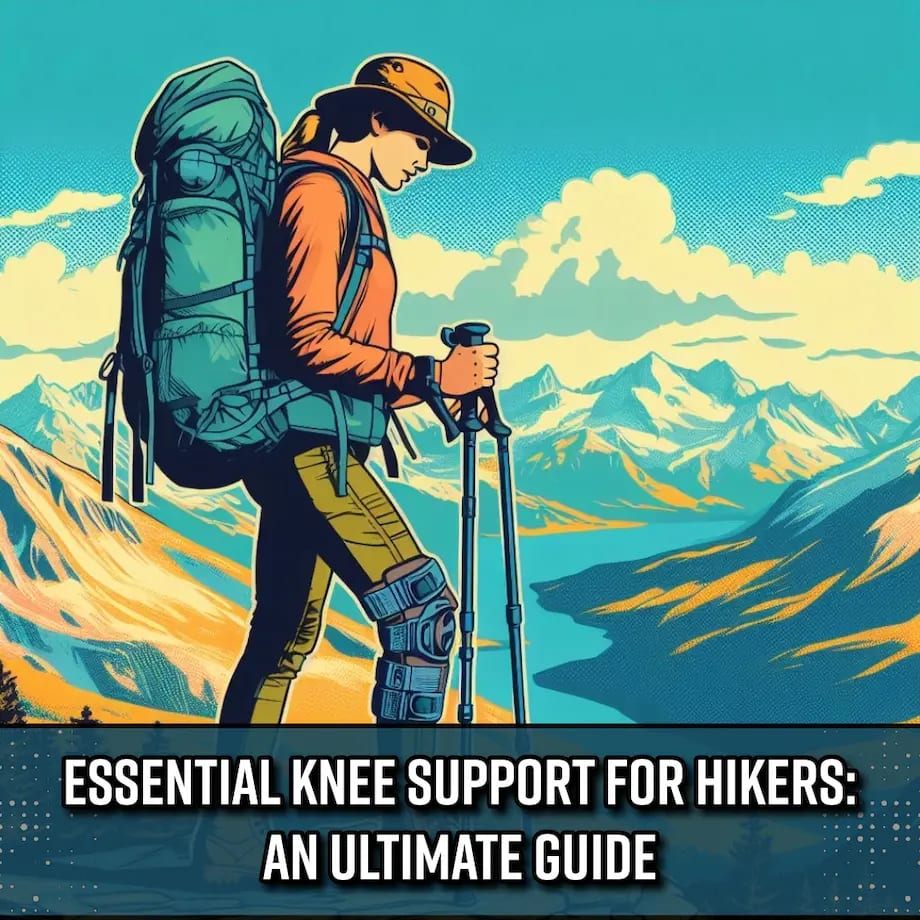Many families hang up their hiking boots at the end of summer. School, pumpkin spice, and rainy weather keep them from getting out in nature. This is a shame. Fall is a beautiful time to go hiking, with the changing colors of the leaves and the crispness in the air. However, it’s important to be prepared for the cooler weather and potential hazards that come with the autumn season. Here are some simple fall hiking tips to keep you and your family warm and safe on your outdoor adventures.

Key Takeaways:
- Prepare for changing weather conditions by checking the forecast and trail information.
- Dress in layers for warmth and comfort, including wool socks, waterproof boots, and a fleece jacket.
- Pack essential gear and supplies such as navigation tools, a first aid kit, and extra food and water.
- Know your hiking speed and estimated return time, and notify someone of your plans.
- Be aware of your surroundings on the trail, avoiding hazards and staying on the designated path.
- You can get more fall hiking safety tips here.
Enjoy the Beauty of Fall on Your Hikes
Fall hikes offer a breathtaking display of natural beauty, with vibrant colors and picturesque landscapes. As you venture out into the great outdoors, take the time to appreciate the changing scenery and capture the magic of the season through nature photography.
Immerse yourself in the serene surroundings, and let the tranquility of the autumn wilderness rejuvenate your senses. As you meander along the trails, keep an eye out for unique opportunities to spot wildlife in their natural habitat. Fall is a time of increased activity for many animals, making it the perfect season for wildlife spotting.
Witness the graceful flight of migrating birds, the playful antics of squirrels collecting acorns, or the majestic presence of deer grazing in the distance. Don’t forget to bring your camera and capture these awe-inspiring moments to cherish forever.
The beauty of fall extends beyond the visual spectacle. Breathe in the crisp, cool air and immerse yourself in the symphony of sounds that nature provides. The crunch of leaves beneath your feet and the gentle rustling of the wind through the trees create a melodic soundtrack to your hiking adventure.
So, lace up your hiking boots, grab your camera, and set off on a journey to explore the wonders of fall. Whether you’re surrounded by fiery reds, golden yellows, or earthy browns, the beauty of the season awaits you on every trail. Fall hiking offers a unique and enchanting experience that will leave you with lasting memories.
Watch the weather.
In the fall the weather can be unpredictable and it tends to change faster than it does in the summer. Check the weather forecast before you head out, and keep an eye out for changing conditions. Don’t hesitate to cut your hike short if the weather starts getting rough. Being caught out in bad weather isn’t any fun, and can get dangerous as well. Also check the the trail conditions and recent weather patterns. This can help you anticipate any potential hazards or challenges you may encounter along the way.

Be prepared for changing trail conditions
Fall is a season of change, and this includes the conditions of hiking trails. As the weather shifts and leaves begin to fall, it’s important to be prepared for the potential hazards that come with it. Here are some tips to help you navigate the changing trail conditions and ensure a safe hiking experience.
Slippery Trails
One of the most common challenges during the fall season is slippery trails. Fallen leaves can create a slick surface, making it easy to lose your footing. It’s essential to wear appropriate footwear with good traction, such as hiking boots or shoes with rubber soles. Take your time and watch your step, especially on steep or uneven terrain. Use trekking poles for added stability if needed.
Icy Conditions
In colder regions, early fall can bring frost and icy patches to hiking trails. These conditions can be particularly dangerous, so it’s crucial to be extra cautious. Consider using crampons or traction devices that attach to your boots to improve grip on icy surfaces. Take slower and smaller steps to maintain balance. Avoid hiking in icy conditions if you’re not adequately equipped or experienced.
Other Potential Hazards
Along with changing weather and trail conditions, fall also brings potential hazards that you should be aware of. Keep an eye out for fallen branches or trees that may obstruct the trail. Be cautious when crossing streams or rivers, as water levels may be higher due to rainfall or melting snow. Stay on marked trails to avoid getting lost or stumbling upon unsafe areas. If you encounter any wildlife, maintain a safe distance and respect their space.
Be aware of hunters
Fall is hunting season in much of the world so if you are planning a hike in an area that allows hunting, wear a hunter’s orange vest and beanie. This will help hunters distinguish you from whatever they are hunting for.
Be extra aware of bears
Like hunters, bears are more active in the fall as they try to build up their fat stores for the winter. If you are hiking in bear country watch for their signs and make noise so that you don’t surprise one. Carrying a can of bear repellent is always a smart idea as well. You might want to check out our bear safety guid for hikers if you aren’t used to hiking around bears.
Don’t forget the first-aid kit
It is easy to forget to bring the first-aid kit while packing for fall hiking. There is a lot more to pack so this can get left out. As always we recommend putting together your own first-aid kit instead of buying one.

Pack the necessary gear and supplies
When going on a fall hike, it’s crucial to pack the necessary gear and supplies to ensure a safe and enjoyable experience. By ensuring you have these essential items, you’ll be well-prepared for any situation that may arise during your fall hike. Here’s a checklist of essential items you should bring:
- Hiking boots or shoes that provide good traction and ankle support
- Appropriate clothing for the weather, including moisture-wicking layers, a warm jacket, and a hat
- Navigation tools such as a map, compass, or GPS device
- A first aid kit with essentials like band-aids, antiseptic ointment, and pain relievers. See our article on creating a DIY Hiker’s First Aid Kit
- Food and water to keep you energized and hydrated throughout the hike. See our article on picking the right foods to take hiking
- Sunscreen and insect repellent to protect your skin from critters and the elements
- A whistle or signaling device in case of emergencies
- A headlamp or flashlight for visibility in low-light conditions
- A multi-tool or knife for various purposes
Dressing For Fall Hiking
Probably the biggest challenge when hiking in the fall is staying dry and warm. Unlike in the summer, when getting a bit wet is a relief, getting wet when it’s cold outside sucks.
Wool is better than cotton for cold weather
Wool is the best material to choose when dressing for colder weather. It is a better natural insulator and will even keep you warm when it gets wet. Wool also dries out faster than cotton.
Dress in layers
I doubt you need us to tell you to dress in layers during the fall. We still will though. Whenever we go out hiking in the fall we make sure the kids wear at least three layers. Here’s a guide on how to dress in layers:
- Base layer: Start with a wicking base layer made of materials such as merino wool or synthetic fibers. This will help keep moisture away from your skin and regulate your body temperature.
- Insulating layer: Add an insulating layer, such as a fleece jacket or down vest, to provide warmth in cooler temperatures.
- Outer layer: Finish with a waterproof and windproof outer layer to protect you from rain, snow, and wind. Look for jackets or shells with breathable fabrics to prevent overheating.
Bring extra socks
Taking an extra pair of socks is always a smart idea, but it is especially important in the fall. Everyone should have at least one extra pair of warm wool socks. This way if your feet get wet you can swap them out.
Pack rain gear
The clothes you are already wearing should be good enough for light showers but you will want to be ready for more. Being miles from the car, soaking wet, and cold is awful so everyone should bring a waterproof poncho. Make sure to get one that will go over your pack and is a bright color (see earlier warning about hunters).

Adventure World Globotrekker Lightweight Backpack Poncho (Multiple Color Options Available)
Picking the right hiking hats for fall weather
Last time I counted there were like a billion hat styles to choose from. For that reason, I’m not able to tell you exactly which one to get. Instead, I’m going to tell you to take two hats. One should protect you from the sun and rain, and the other should protect you against the cold.
For cold weather protection, the choice is easy. Get your favorite beanie or knitted cap and put it in your pack. When it gets cold, you can put it on. Beanies are perfect for this because they aren’t heavy or bulky and everyone has a few already.
For sun and rain protection I recommend a sturdy waterproof shade/bucket hat. There are a lot of choices, so pick your favorite. Our family loves Tilly hats but they are a bit expensive. You can pick up a very high-quality hat for under 20 dollars so don’t feel like you have to invest a lot here.

Tilley Endurables LTM6 Airflo Hat Tilley's best-selling broad brim AIRFLO hat sets the standard by which all other outdoor hats are measured. Constructed of lightweight, breathable Supplex nylon with a cooling 3/4" AIRFLO mesh band in the crown, this topper provides excellent sun protection, ventilation and moisture management - and may very well be the last hat you ever buy!
Picking the right boots
Like hats, there are many different brands and styles of hiking boots. The most important thing is that they fit and are comfortable. The weight and ankle height are up to you to try and see what you like. We recommend water-resistant or waterproof boots from a top brand for fall hiking. We aren’t going to give any specific recommendations because you shouldn’t buy boots without trying them on first.
Top Hiking Boot Companies
We said we wouldn’t recommend specific boots but these are our four favorite brands.

In Conclusion
Since moving to New Mexico we have been going on more and more fall hikes in the mountains where the temperature and weather can vary drastically throughout the day. This has made us pay more attention to the challenges that this time of year brings. Remember, dressing in layers is crucial to adapt to changing weather conditions and keep warm. Don’t forget to pack the necessary gear and supplies, including a map, compass, first aid kit, and extra food and water. Knowing your hiking speed and estimated return time, as well as staying aware of your surroundings on the trail, are essential for a successful and secure hike.
Let’s not forget to savor the beauty of autumn while hiking. Take in the stunning scenery, capture moments with your camera, and keep an eye out for wildlife. With these fall hiking tips in mind, we can enjoy the outdoors in autumn, appreciating all that nature has to offer while staying safe and prepared. Hopefully these tips help you have a more comfortable and safe hiking trip. If you have anything to add we would love to hear from you on social media. Stay safe and get outdoors.
FAQ
Q: What should I do to prepare for changing weather conditions on a fall hike?
A: Check the weather forecast before heading out and be aware of any potential rain or snow. Also, check the trail conditions and any potential hazards that may be present.
Q: How should I dress for fall hikes?
A: Layering is key when it comes to dressing for fall hikes. Start with a wicking base layer, add an insulating layer like a fleece jacket, and top it off with a waterproof outer layer. Don't forget to wear warm socks, waterproof boots, gloves, and a hat to keep your extremities warm.
Q: What essential gear and supplies should I pack for a fall hike?
A: Some essential items to include are a map and compass for navigation, a first aid kit for emergencies, extra food and water for sustained energy, and a water bottle or hydration pack to stay hydrated.
Q: How can I estimate my return time and hiking speed?
A: Take into consideration the elevation gain or loss, your fitness level, and the terrain. Make sure to notify someone of your travel plans, including your destination and return time, in case of emergencies.
Q: What should I be aware of when hiking on the trail?
A: Pay attention to the trail, stay on the designated path, and avoid wandering off. Take note of any potential hazards, such as steep embankments or loose rocks, and be cautious when navigating them. Referencing a map at major junctions can help you stay on track and avoid getting lost.
Q: How can I stay hydrated and nourished on a fall hike?
A: Carry enough water for your entire trip and take regular water breaks. Pack lightweight and high-energy snacks such as trail mix, energy bars, and fresh fruits. Consider the extra calorie burn and energy expenditure due to cooler temperatures.
Q: What trail conditions should I prepare for during the fall?
A: Keep an eye out for slippery trails due to fallen leaves or rain. Be cautious of icy conditions, especially in shaded areas. Watch out for potential hazards such as fallen branches or uneven terrain.
Q: Is it safer to hike with a buddy?
A: Hiking with a buddy is a great way to ensure safety on the trail. Having someone by your side can help in case of emergencies or accidents. Plus, it's more enjoyable to share the experience with someone else. Make sure to communicate and stick together throughout the hike.
Q: How can I appreciate the beauty of fall on my hikes?
A: Take the time to appreciate the changing colors of the leaves and the beauty of the season. Keep an eye out for wildlife that may be more active during this time of year.
Q: What safety precautions should I take for hiking in colder months?
A: Dress in layers to stay warm and prevent hypothermia. Protect exposed skin from frostbite by wearing appropriate clothing and accessories. Be aware of the signs and symptoms of both hypothermia and frostbite.
Related Blog Posts

Do your knees hurt when you hike? This post explores the best knee support options for hikers. Whether you're an avid trekker or just starting your hiking journey, discover the importance of proper knee care on the trails. From essential tips to gear recommendations, our comprehensive guide ensures you hike with comfort, stability, and confidence, allowing you to enjoy the great outdoors to the fullest.

Planning a hiking trip and wondering what foods to bring? Our comprehensive guide has got you covered. From high-energy snacks to satisfying meals, we provide tips and recommendations for choosing the right foods to fuel your adventure. Our expert guide covers everything from calorie needs and nutrient-dense options to lightweight and portable foods that won't weigh down your pack.
By Summer and Bill

Summer and Bill are the dynamic duo behind Adventureite.com, a blog dedicated to inspiring others to explore the great outdoors. With a combined lifetime of experience traveling and adventuring across America, they have a wealth of knowledge to share. From hiking to camping, kayaking to travel, Summer and Bill are passionate about helping others discover the beauty of the natural world.
 Adventureite
Adventureite